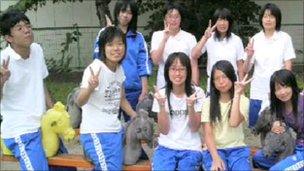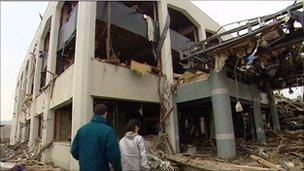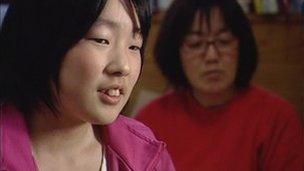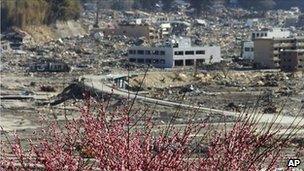Tsunami: Death and survival at school swimming club
- Published
A teacher, Yukiko Horie , prays for the students she could not save. Satellite imagery courtesy of GeoEye
Standing outside Rikuzentakata's community hall, Yukiko Horie clasps her hands together and then touches them to her forehead. She bows and says a quiet prayer.
The three-storey building is still standing, but it has been completely wrecked by the tsunami that swept through just over a month ago.
Someone has placed a small bunch of artificial flowers on a smashed window ledge near what was the main door.
When Yukiko looks up she sighs with grief.
She tells me that in her prayer she was talking to her students. Six of them died here. One is still missing. "I kind of apologised to them, saying I'm sorry that on the day I was not with them, I felt very sorry."
One month on Yukiko Horie is wracked by guilt that she survived while the children died. They were all aged between 16 and 17, and were members of Takata High School's swimming club.
Yukiko, an English teacher, was also one of the two coaches in charge of the club. She was not with the team when the earthquake struck on 11 March but at school.
Hill climb
Of the 11 members of the club, nine had gone to practise at Rikuzentakata's B&G swimming centre down by the seafront. They had just got changed into their swimming costumes when the magnitude 9 quake hit.
Fearing a tsunami, the staff at B&G followed their established evacuation drill and took the nine children a mile or so to the town's community centre, right opposite Rikuzentakata's town hall.

Six members of the Takata High School swimming club died and one is missing
It was a fateful decision. Takata High School was closer, but the community hall was the designated tsunami shelter for anyone at the pool.
At the school, Yukiko Horie had started to evacuate several hundred children who were still in classes.
The second swimming teacher, 29-year-old Motoko Mori, hurried off towards the seaside to try to find the club members and bring them to safety. Ms Mori has not been seen since. She got married in March last year.
Yukiko Horie and the children in school all reached the top of the hill before the tsunami struck. They all survived.
But, down on lower ground, the community hall was swallowed by the waves. Along with the swimming team, many adults were also sheltering inside.
'Pushed them in'
As Yukiko steps into the ruined hall for the first time since the disaster, broken glass and splintered wood crunch underfoot. Torn wires and shredded cladding hang from the ceiling. Twisted panels lie everywhere.
One huge concrete wall and the giant steel girders that once held up the roof of the hall's concert auditorium have all caved in. Rows and rows of seats have been ripped from their mountings. Everything has been smashed to pieces.

The community hall was a designated evacuation area in Rikuzentakata
Incredibly two girls from the swimming team managed, somehow, to survive this. With a mobile phone pressed to her ear, Yukiko is speaking to one of them, Honoka Sasaki, who is in hospital. She is guiding Yukiko through the building.
Yukiko is looking for the storeroom up on the third floor where the two girls clung to each other while the waters swirled around them.
She ends the call as we have to scramble under twisted pipes and then, suddenly, she sees the room. The door is ajar.
"This is the place. It's exactly here," Yukiko exclaims, "it must be. They couldn't open the door, but the wave pushed them in."
Honoka and the second girl, 16-year-old Chihiro Kanno, told Yukiko how they ran upstairs to escape the rising water. But it caught up with them. The water forced the door of the store open, and swept them inside.
"Ah, look," she says, pointing at the wall near the ceiling, "up there, it's very clear you can see the line on the wall where the water reached. It's just a few inches from the top. In that space they had air. They were swimming, just to keep breathing."
Yukiko is making a paddling motion with her hands as if re-enacting the way the girls struggled to keep their heads above the water.
The storeroom is small and dark. The tidemark where the water stopped rising is easily visible, about six inches below the ceiling, which must be 9ft (3m) up.
"How is it possible?" Yukiko says out loud. "The girls! Here! Amazing!"
Swept away
After the earthquake, 16-year-old Chihiro had been crying and panicking. But a third girl from the swimming club had calmed her, telling her not to worry, it would all be fine.
As the tsunami swept into the hall, Chihiro held the girl's hand while they fled upstairs. But when the water forced Chihiro into the storeroom she could not keep hold of her friend. They were pulled apart.

Chihiro Kanno survived in a storage room where water did not quite reach the ceiling
Chihiro and Honoka watched as their teammate was swept across the hall, pressed against an elevator by the wave, then carried away.
"They saw it," says Yukiko. Then she turns. "Here's the elevator. The girl was struggling. The two of them, here, they were watching. But they couldn't help. Oh." And she raises her hands to her face again, sighs, and bows once more.
The two surviving girls were trapped in the storeroom, holding on to each other and struggling to breathe in their air pocket for 10 or 15 minutes until the tsunami receded.
Then, soaking wet, they spent a night trapped in the building in the freezing cold until they were found by a rescue team the next day.
'Find a door'
Honoka Sasaki is still in hospital. She cut her leg on a ventilation fan that was floating in the water and had to have an operation last week.
"Honoka remembers the terrible things and cannot sleep," says Yukiko, "though gradually she is sleeping a little more.
"I don't know how to help her," she adds, "I think the terrible experience will stay with the girls for their lives."

The earthquake and tsunami killed one in 10 residents in Rikuzentakata
Chihiro Kanno was taken to an evacuation shelter. In the chaos after the disaster it took her three days to find her parents. They thought she had died.
Her home has been destroyed so she now lives in a tiny room in an old people's home, along with other evacuees.
Chihiro now has frequent nightmares. She tries to keep busy, to ward off the memories. She is polite and shy.
"We were in the hall on the 3rd floor when the wave came over us," she says in a soft, quiet voice. "I was holding my friend's hand, but we got separated, then she was swept away.
"I was washed into the storage room. I was underwater, my back touched the floor. Above me was wreckage. I dodged it and swam up. There was a small space between the ceiling and the water, I could breathe there.
"I heard Honoka say 'Are you there, Chihiro? Find a door.' We held each other and waited until the water drained away."
Chihiro wants to get back to school as soon as possible to be with her friends. But the tsunami destroyed her town of Rikuzentakata. Of its population of 23,000, one in 10 is dead or missing. Half have lost their homes.
'Can't sleep'
All around Rikuzentakata teams of soldiers are clearing up the broken buildings. They are depositing smashed wood, twisted metal and wreckage in neat piles. The fabric of an entire town is being carried away so Rikuzentakata can be rebuilt.
But the many, many broken lives here and in other towns for hundreds of miles along the coast may never be repaired.
Japan's Red Cross says up to one in 10 of all survivors from Japan's earthquake and tsunami might now suffer post traumatic stress disorder. That could be tens of thousands of people. The trauma may be the legacy that weighs the longest on Japan.
Takata High School is a wreck. The reinforced three-storey building is still standing. But the sports hall was picked up and rammed into one side of the school. Every classroom is full of debris.
Yukiko Horie, the swimming teacher, walks slowly through the building. She cannot escape her feelings of guilt that she could not save her students.
"At night I can't sleep," she says, "I imagine many things because I was not with them in that building. How horrible it was. The fear. How cold was the water. How scared [they were], the black water."
"I imagine I could see [how] they tried to struggle and they are good swimmers, maybe they tried to swim and go up, but I couldn't help them."
Now Yukiko is working with the other teachers to open a new, temporary school for the surviving children. She says she tries to be strong for her students.
"These days I am thinking if they were here, the swimming members, what they will tell me," Yukiko says. "I imagine, maybe they will ask me to try not to be so sad, to just stand up. I think they will tell me that. So that's my strength."
And then she adds, "sometimes the swimming members appear in my dream and they also make me laugh."
"I should step forward, so I try not to be thinking of the sad stories. I have a responsibility to step forward."